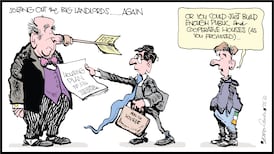BOOK OF THE DAY: Born to Run: The Rise of ultra-running and the super-athlete tribeBy Chris McDougall Profile Books 288 pp, £16.99
RUNNING IS booming again, just as it did during the recession of the 1970s and the Great Depression. In this entertaining and often exhilarating trip down its wackier trails, American sports journalist Chris McDougall attributes the appeal of running to “the way it unites our two primal impulses: fear and pleasure”.
“We run when we’re scared, we run when we’re ecstatic, we run away from our problems and run around for a good time. And when things look worst, we run the most,” he tells us at the start of a dizzying narrative filled with large dollops of anthropology, orthopaedic pop science, comic characterisation and race commentary. His point: man is, as the title claims, “born to run,” preferably barefoot.
McDougall trawls the scientific research to back his claim that the human body is specifically designed for running. It’s why we have Achilles tendons in our feet, when chimps don’t, as well as big backsides and a nuchal ligament to stabilise our head when striding forth. The reason, it seems, why man successfully evolved when other stronger species bit the dust lies in our Homo sapiens ancestors’ ability to outrun the animals they wanted to eat. Not by running faster, but by running longer.
The bushmen of southern Africa still practise this persistence hunting, chasing an antelope for hours until their quarry, far quicker over short distances, collapses in exhaustion.
But I digress. And so does McDougall, repeatedly. This is an onion of a book, with each layer telling a story. Essentially, it is about ultra-runners, people who grind out mile after mile in races that make the standard marathon look like a short sprint. Running 100 miles in 24 hours or so might seem like a grim way of spending the weekend, but the characters in this book burst with colour and an exuberance that – almost – makes their running sound fun.
One runs in a string bikini, stopping to quaff beer at rest-stops; another garrulous character known as “Barefoot Ted”, preaches the virtues of barefoot running and is reputed to practise by pulling his wife and children around in a rickshaw.
There’s also a mysterious American dropout known as Caballero Blanco, who lives and runs in the mountain of Mexico.
It is in these mountains, the Copper Canyons, that McDougall finds his version of the noble savage, the ultra-running Tarahumara tribe. The terrain here is straight from The Treasure of the Sierra Madreor a Cormac McCarthy novel, but like many a writer before, McDougall all but claims to have discovered a less developed people and then proceeds to idealise them. We get lengthy disquisitions on the unsullied ways and rich diet of this "near-mythical tribe of Stone Age super athletes" who are "reputed" to be the best distance runners in the world.
Little enough evidence is put forward to support this assertion, although a 57-year-old Tarahumara did win a 100-mile race in the US in 1993 wearing a toga and sandals. But don’t let that put you off; the author’s gonzo-esque search for the tribe and his organisation of a madcap race between their best runners and a handful of US ultra-runners is hugely entertaining.
Along the way, he points out that in spite of all the fancy and expensive footwear we use to cushion our strides, running injuries are become more prevalent. The cushioning does nothing to reduce the impact on your legs, not when the impact can be up to 12 times your weight.
“You can cover an egg with an oven mitt before rapping it with a hammer, but that egg ain’t coming out alive”, he writes.
“Putting your feet in shoes is similar to putting them in a plaster cast,” renowned Irish physical therapist Dr Ger Hartmann is quoted as saying. “If I put your leg in plaster, you’ll find 40 to 60 per cent atrophy of the musculature within six weeks. Something similar happens to your feet when they’re encased in shoes.”
A hack runner himself struggling to be injury-free, McDougall delivers a few “painful truths” based on his research. The best shoes are the worst. Beat-up shoes are better than new ones. Human beings are designed to run without shoes.
Even if McDougall doesn’t go barefoot all that much himself, this is one of the most joyful and engaging books about running to appear for many years.
Paul Cullen is an
Irish Times
journalist and sometime runner











